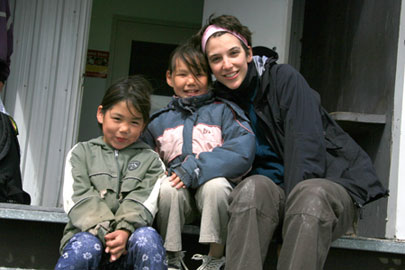Taking a people's pulse from the sea
Taking a people's pulse from the sea McGill University
User Tools (skip):
Notes from the field
Taking a people's pulse from the sea

Angela Pacey, doing her Master's in the school of Dietetics and Human Nutrition and the Centre for Indigenous People's Nutrition and Environment, enjoying time with kids in Sanikiluaq, Nunavut.
It's 7:30 in the morning, and the sun has been up for hours. At this time of year in Sanikiluaq, or "Sani" as the local Inuit like to say, the sun rises almost as soon as it sets. We're waiting at the shore of Hudson Bay for the first group of people who will participate in the Inuit Health Survey for Nunavut.
The shore—it's an odd meeting place for conducting health research but that's what happens when Dr. Grace Egeland, my supervisor and Principal Investigator for the project, rents out the Canadian Coast Guard Ship, the Amundsen, and converts it into a floating research site in order to conduct a cross-sectional Inuit Health Survey. Sanikiluaq is the first of eighteen communities that will be visited by the Amundsen in August as it travels throughout the Kivalliq and Baffin regions of Nunavut. Most Inuit of Nunavut live on the coast, so a territory-wide health survey makes much more sense by sea than by air. About half of the flights in the Canadian North are delayed by days or weeks, usually due to weather.We arrived in Sanikiluaq, in the Belcher Islands of Hudson Bay, on a flight from Montreal with two stops in Nunavik. As we traveled North, the trees grew smaller until they eventually disappeared, the air grew colder, and the mosquitoes? Well, the mosquitoes grew bigger, so big that they managed to muscle their way through my jeans, my long underwear and my wool socks. But we were welcomed to Sanikiluaq with the warmth that only a community of 800 could give. Each night's sunset seemed to top the one before. I've never seen the Canadian sky so beautiful—soon the size of the mosquitoes didn't seem to matter anymore.
I am here with my co-worker, Nancy Faraj, a registered dietician who has already taught every kid in town how to play Ultimate Frisbee. They have a game every Monday and Tuesday. Together with four community members that Nancy hired and trained, we are recruiting participants and conducting interviews about health and wellness, country food (traditional foods obtained through hunting and fishing), food security and household living conditions. We're asking questions like "How much Beluga do you eat in a year?" "Do you feel your community is a peaceful place?" and "Is there an active hunter in your household?"
We're also scheduling people for appointments on the CCGS Amundsen where nurses will assess anthropometry, nutritional status, cardiovascular health, diabetes risk and exposure to environmental contaminants. Between interviews and scheduling, we're conducting a similar survey for pre-school children so we get to spend at least some time making funny faces to distract kids from the blood draw the nurse is about to do. After three weeks, we've recruited enough adults and children so we take a day off to learn how to fish. I didn't catch anything (which is good because I don't have a fishing license) but we were invited to eat fresh, raw char caught by Inuit hunters who have more patience for fishing than I do.
We owe our research successes in Sani to the closeness and sense of community that exists here. "Kinauvit?" (Who are you?), a kid asks me. I tell her, and the next day, every kid in town knows my name. Word spreads quickly around here and it is that momentum that will make the Inuit Health Survey possible. It is a lot that we are asking of participants: three hours of interview time, an overnight fast and an appointment on the ship with two blood draws. We weren't sure how people would respond. But, as I said, word spreads quickly around here. The first few participants told their friends and families that they thought our questions were worthwhile; that the health survey was important for Inuit. Everyone became excited and eager. It brought smiles to our faces when locals approached us over morning coffee "When are you going to call me about being in the health survey?"
On that note, it's 7:30 in the morning and we're waiting at the dock for the first group of participants. It is warming up around Hudson Bay and in the distance, the patriotic red-and white ice-breaker dispatches the small boat that will bring the participants aboard. I'm worried that we scheduled appointments far too early in the morning; that people will decide as they lay in their warm beds that it isn't worth getting up for the Inuit Health Survey. But shortly, in a convoy of ATVs, all of the participants arrive. I guess I fleetingly forgot that I'm in Sani, a place where people smile a lot, are eager to be a part of their community and find excitement in activities like getting up early to board the Coast Guard ship for a health survey. Silly me.
Angela Pacey moved to Montreal in 2006 to start her Master's in the School of Dietetics and Human Nutrition and the Centre for Indigenous People's Nutrition and Environment (CINE). Her supervisor is Dr. Grace Egeland, Canada Research Chair and Principal Investigator for the Inuit Health Survey for Nunavut, Nunatsiavut and Inuvialuit (www.inuithealthsurvey.ca). The Inuit Health Survey is an International Polar Year project. Angela's Master's research focuses on iron deficiency in Inuit children. When she's not romping around and doing arts and crafts around with kids in Nunavut, she's usually romping around and doing arts and crafts with her roommates in Montreal.
If you're a McGill researcher conducting fieldwork this summer and you'd like to file a piece for this series, contact Neale McDevitt at 514-398-1044 or neale.mcdevitt@mcgill.ca.

